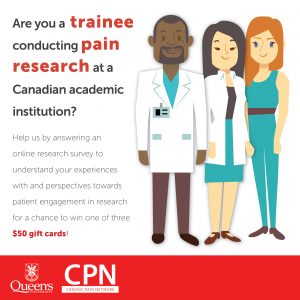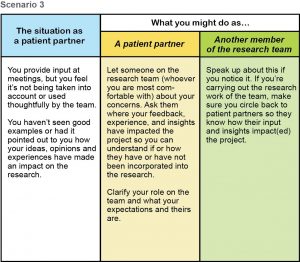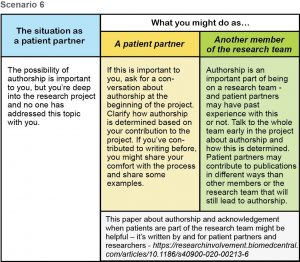Authors: Therese Lane, Dawn Richards & Kyle Vader

Patient engagement (PE) in research is defined as “meaningful and active collaboration in governance, priority setting, conducting research and knowledge translation.” Despite recognition of the value of PE in pain research (e.g., funding of the CIHR-funded Strategy for Patient-Oriented Research (SPOR) Chronic Pain Network), little research has been published on the implementation of PE by certain groups, such as pain research trainees. A better understanding of current perspectives and experiences, perceived barriers/facilitators to implementation, and recommendations may help to improve how PE is done by pain research trainees.
We’re using this blog to describe our experiences as a diverse group of researchers (e.g., patient partners, trainees, and faculty members) who came together to better understand the current state of PE amongst pain research trainees in Canada. The idea for this work came about after several informal discussions between a group of trainees conducting pain research who had various degrees of exposure to PE in research. Following these discussions, we decided to conduct an online survey (in French and English) to understand more. With the support of the PE Committee of the Chronic Pain Network, we secured funds to support the operating costs of this work. In keeping with the overarching principles of PE, patient partners were involved throughout this work, from study conceptualization to survey development, survey dissemination, analysis, and knowledge sharing. To facilitate deep and rich PE, we found that from a process perspective, using a combination of meetings specifically with patient partners as well as our entire research team was helpful.
In the end, our survey consisted of 20 questions, including a combination of closed- and open-ended questions. We shared our survey through targeted emails and broadly through social media (e.g., Twitter posts). Our final analysis included 115 survey responses (105 English; 10 French). Among our respondents, 89.6% (103/115) reported that PE is ‘very’ or ‘extremely’ important. Despite this, 58.6% (65/111) reported that they ‘never’ or ‘rarely’ implement PE in research when they are the primary researcher (e.g., their thesis research).
When respondents were asked to provide recommendations for implementing PE amongst pain research trainees, they provided diverse responses. Using qualitative content analysis, we identified four key recommendations. They are to:
1) Improve availability and accessibility of training opportunities and resources on PE in research,
2) Provide more funding opportunities that support and/or require PE in research,
3) Create systems to support trainees to find patient partners, and
4) Ensure that supervisors, departments, and institutions support and encourage PE in research.
From this work, we have learned that although most pain research trainees in Canada see value in PE, many are not implementing it in their own research. Our hope is to build a community of pain research trainees and patient partners who can work together to co-design and implement patient-oriented research projects across the research continuum. We hope to create practical resources and solutions (e.g., tools, toolkits, simple guides, apps) so that pain research trainees can work collaboratively and effectively with patient partners.






 Download .pdf:
Download .pdf: